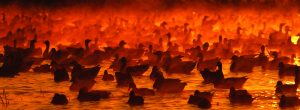Waterfowl migration
The spring migration of ducks and geese in Nebraska is hard to ignore as endless streams of vocalizing ducks and geese flyover head before landing in fields to forage.
From February to mid-April, millions of waterfowl of more than 25 species pass through Nebraska during their migration along the central flyway. From mid-February to early March across the state, fallow fields are filled with large white masses of hundreds to thousands of snow geese.
Mixed flocks of Canada and Cackling Geese can be observed across the state while flocks of Greater White-Fronted Geese typically stick to the eastern portion of the state. The strikingly different plumages of ducks is always worth admiring. From the long, pointed tail of Northern Pintails, the lustrous cinnamon head of Redheads, the distinct spoon-shaped bill of Northern Shovelers, the gleaming white crown and green eye patch of American Wigeon, to the subtle beauty of the Gadwall, the endless colors and unique characteristics of the ducks migrating through Nebraska is always a treat.
No matter what part of the state you are in, there are great places to view waterfowl nearby. Large waterbodies that have open water during the frigid winters are excellent places to check for a variety of species. A spotting scope can be helpful at many of these sites to view distant birds on the water. Many species of ducks and geese follow the Missouri River corridor northward and often trailing the birds are Bald Eagles. The Rainwater Basin is not only a great area to view shorebirds, but is also great for viewing a variety of ducks and thousands of geese. The shallow lakes in the Sandhills attract a wide variety of ducks and some like the Blue-winged Teal and Northern Shovelers stick around to nest here. In the western part of the state, Lake Minatare and Lake McConaughy attract thousands of waterfowl.
Suggested Sites
Visit these sites for peak opportunities to observe the waterfowl migration.
- Harvard Waterfowl Production Area
- Branched Oak Lake State Recreation Area
- Ponca State Park for guided and unguided opportunities to view waterfowl from blinds during Marsh Madness in March.

